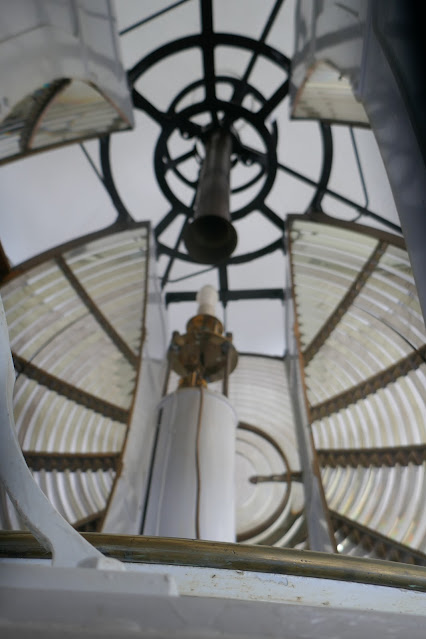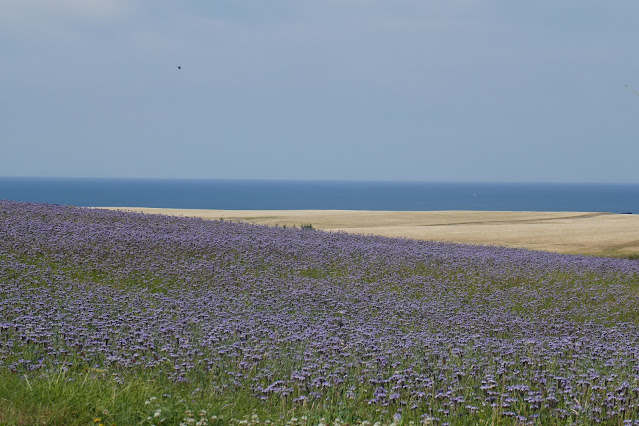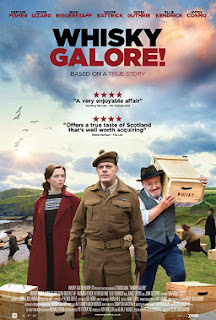Lighthouses and a Salmon Bothy
Setting the Scene
 |
| Scotland |
 |
| Moray |
 |
| Our travels around Findochty fit neatly into the red oval |
Findochty to Fraserburgh
Findochty to Fraseburgh is 54km (33miles) as the crow flies, but as almost the whole route would be over water, it is strictly a bird route. The A98 makes a dip to the south pushing the distance up to 69km (43miles). It makes the driving easier, but I tapped ‘shortest’ rather than ‘recommended’ to make life more interesting.
 |
| Moray and Aberdeen |
 |
| Aberdeenshire |
The A98 took us to Portsoy (of which more later) and from there our sat nav selected a direct approach to Banff along the B9139. The extraordinarily
narrow road ran across flat farm land, with a view of the sea to the left – or so
I am told, I kept my eyes on the road. We saved about 1km on an 8km journey, but it took longer and the breaking and accelerating probably used more fuel.
Banff and Macduff (they have their own post here) are small towns either side of the mouth of the River Deveron. Until the 1975 reorganisation, Banff was the county
town of Banffshire. The coast of Banffshire ran from west of Buckie to
Gardenstown, while the hinterland straggled southwest in the shape of a
carelessly wrung out floorcloth. It is now divided between Moray and
Aberdeenshire.
The B9031 from Macduff to Fraserburgh is pleasant road that cuts off the southern loop of the A98, but introduces plenty of
smaller digressions of its own. The road runs mostly through farmland on a plateau
some 100m above the coastal strip but at Pennan it descends to the harbour. Half
a mile before the village the road drops steeply out of view suggesting that if
you put your foot down hard you would take off and soar serenely out to the sea. Actually, you
wouldn’t.
Fraserburgh and The Museum of Scottish Lighthouses
We drove through Fraserburgh to our destination, Kinnaird Head on the north east corner of the town and a candidate for the most
north-easterly point in Scotland. Scotland’s particular shape provides a second
candidate, Duncansby Head near John o’ Groats which is much further north but
nowhere near so far east. As there is no definition of ‘most north-easterly’, it’s your choice.
The award winning Fraserburgh Heritage Centre would have been worth a visit, but unfortunately Storm Arwen removed the roof in
November 2019. The volunteers who run the Heritage Society still
seem to be active online, but there is as yet no sign of a re-opening, or re-roofing.
 |
| Fraserburgh Heritage Centre |
On the same site is the rather better roofed
Fraserburgh Museum of Scottish Lighthouses. We popped through the Hobbit hole to
buy tickets, then popped out again and walked round the back.
 |
| Museum of Scottish Lighthouses, Fraserburgh |
It is a reasonable possibility that a lighthouse museum might contain a lighthouse, but not inside the building, obviously. The Kinnaird Head Lighthouse, round the back, is a remarkable, possibly unique example.
 |
| Kinnaird Head Castle and Lighthouse |
Sir Alexander Fraser, 8th laird of Philorth, an area to the south of the modern town, built himself a castle on Kinnaird Head in 1570. Nine years later he built a port nearby and in 1588 he obtained a charter establishing it as a 'burgh of barony'. His building works having combined the villages of Faithlie and Broadsea, he successfully sought the right to rename the newly created town Fraserburgh.
One Fraser or another lived in the castle until they ran out of Frasers in 1764. In 1787 the building was leased to the Northern Lighthouse Board which had been
set up ten years earlier to improve safety at sea. Thomas Smith, the board’s first chief engineer set a whale oil lantern backed by an
array of parabolic reflectors on the castle tower. The most powerful light of
its day it, was visible from as much as 22km.
In 1824 Robert Stevenson erected a new lighthouse tower within the castle with a new improved lantern and reflector array.
Robert Stevenson was the stepson and former apprentice of Thomas Smith. He built 18 lighthouses in his career, the most remarkable being
the Bell Rock Lighthouse, 11km east of the Firth of Tay and the oldest
sea-washed lighthouse still standing. He also spawned a dynasty of lighthouse
engineers, the family tree being set out in the adjacent museum.
 |
| The Stevenson family |
Alan Stevenson, installed a first order dioptric lens at Kinnaird Head in 1851. The first purpose-built accommodation blocks were designed
by David and Thomas Stevenson in 1853. In 1902 David Alan Stevenson installed a
flashing lens apparatus designed by himself and his brother Charles Alexander
Stevenson that was visible form 40km away. The black sheep of the family was
Robert Louis Stevenson, author of Treasure Island, Kidnapped and
more, but he was as successful in his chosen career as the rest of the family were
in theirs.
I also learned not to confuse Robert Stevenson with Robert Stephenson, member of another dynasty of engineers, but railway
rather than lighthouse focussed. Robert Stephenson was busy building ‘Stephenson’s
Rocket’ when Robert Stevenson was industriously constructing Tarbert Ness
lighthouse.
Climbing the stairs of Robert Stevenson’s new tower….
 |
| Climbing Stevenson new tower, Kinnaird Head lighthouse |
….we dropped in on the keeper’s room, looking untouched since the 1970s. There was always a duty keeper in case of emergency
and, in the early days, to carry the oil up the stairs and replenish the tanks.
 |
| Keeper's accommodation, Kinnaird Head lighthouse |
Emerging on the roof of the castle…
 |
| On the roof of Kinnaird Head Castle |
…there is a good view over the town of Fraserburgh…
 |
| Fraserburgh |
…and over the docks. Fraserburgh is a major fishing port, the largest shellfish port in the UK and one of the largest in Europe.
 |
| Fraserburgh fishing port |
You can also look down on the modern lighthouse, which does not need a fulltime keeper, and the now redundant foghorn.
 |
| The modern Kinnaird Head lighthouse |
Back inside the lighthouse, we inspected the business end…
 |
| The business end of Kinnaird Head lighthouse |
…before descending the steps to see the Kelvin diesel engines installed in 1950, replacing the earlier paraffin fuelled
engines which had replaced the youngest keeper manhandling the fuel up the stairs.
 |
| Kelvin 44-HP diesel engines |
Outside we had a look at the Stevenson designed keeper’s accommodation…
 |
| Stevenson designed keeper's accommodation, Kinnaird Head |
…and then made our way into the museum itself. The Kinnaird Head lighthouse was by far the most interesting part of the museum. Inside, the display of lenses and reflectors would have been interesting to the specialist, but apart from the pleasing shapes, meant little to the average lighthouse ignoramus like me. On the other hand, I always appreciate photographs of lighthouses standing on lone wave-lashed rocks way out to sea.
 |
| Fraserburgh Lighthouse Museum |
Lunchtime arrived so we dropped in to the museum café. The chicken stuck between two slabs of bread had been freshly cooked, not taken from a packet and pinged in a microwave. That earned a bonus point.
Record Temperatures
Driving back west, the brilliant sunshine displayed the coastline at its best.
 |
| Driving west from Fraserburgh |
It had been breezy up the lighthouse, Kinnaird Head Lighthouse holds the record for the UK’s highest ever low-altitude wind speed (142 mph
(229 km/h) in February 1989) and it was not until we stopped for fuel at a less
exposed location that we realised how warm it was. The 18th and 19th of July
2022 saw temperature records set in Scotland, Wales and England. Coningsby in
Lincolnshire recorded a toasty 40.3°C, while Charterhill in the Scottish Borders
set a more modest Scottish record of 34.8. Beside the Moray Firth, some 230 km
further north, it was, of course, cooler, the temperature gauge in my car read
a steady 28°, though for some reason the Met. Office does not accept that as an
official record.
Portsoy and its Salmon Bothy
Portsoy is bigger than most surrounding villages with a well-defined centre. Leaving the main road we descended towards the picturesque
harbour nestling at the base of a small headland. The harbour has enjoyed something of a showbusiness career, appearing in Peaky Blinders and starring in the
2016 remake of Whisky Galore!
 |
| Whisky Galore! |
There was a DVD of Whisky Galore! in our borrowed cottage, so we watched it one evening. During WW2, when whisky is rationed, a
ship carrying 50,000 cases of Scotch runs aground off the fictional island of
Todday. The customs officer, the home guard, the police and the islanders all have their own ideas about what should
happen next. Compton Mackenzie’s novel was written in 1947 and he wrote the
screen play for the 1949 film which puts the 2016 version at a disadvantage,
but the setting is beautiful photographed, the cast led by Gregor Fisher and
Eddy Izzard seem to have enjoyed making it and we enjoyed watching it. It had
mixed reviews; I understand why it did not go well in America, but the British reviewer
who described the film as Too restrained and polite to really grip the
attention missed the whole point. There are no real villains, there is no shooting, no loud explosions, no special effects, but who needs them?
Round the other side of the headland is Links Bay…
 |
| Links Bay, Portsoy |
…which is the wide mouth of the tiny Burn of Durn. I suspect this is not a true ria, but that is a question for a geography teacher,
not a former maths teacher.
 |
| Links Bay and the mouth of the Burn of Durn, Portsoy |
Beside Links Bay is the Portsoy Salmon Bothy…
 |
| Portsoy salmon bothy |
…and what, you might well ask, is a salmon bothy?
A bothy, from the Gaelic bothan meaning a hut, is a basic shelter, left unlocked and available for anyone to use free of
charge. They were intended for estate workers and farmers but the decline of hill
farming means upland bothies are now mostly used by hill walkers.
The Portsoy salmon bothy was purpose built in 1834 by the Seafield Estate, owners of the local salmon fishing rights. Larger and more
elaborate than a standard bothy, it provided an office, ice house, fish
preparation area, workshop and storage accommodation as well as shelter and
sleeping accommodation for the fishery workers.
 |
| Ice chamber, Portsoy salmon bothy |
Stake-net salmon fishing began near the mouth of the burn in 1828 and continued until 1990 when the decline in salmon numbers brought it
to a halt.
 |
| Boat used by salmon fishermen, Portsoy salmon bothy |
The bothy was left unused until 2008 when it was acquired by Portsoy Community Enterprise who raised money for its restoration. It now houses a museum in the former ice chamber while the netting loft is a community space and venue used for performances and by local clubs and societies
Back to Findochty
By some remarkable co-incidence we arrive back at Findochty at precisely beer o’clock – strange how often that happens.
 |
| Beer o'clock, Findochty |
Sunshine always attracts kids to the water, and quite a crowd spent several hours taking turns to demonstrate their bravado by jumping off the harbour
wall. The air was warm, but the water may not have been and most seemed, at
least from our distance, to be wearing wet suits.
 |
| Jumping off the harbour wall, Findochty |
Later we walked as far north as we would venture on this trip to see the evening sun illuminating the Moray Firth.
 |
| The Moray Firth, Findochty |
Part 1: Glasgow (1) Irn Bru, The Clyde and La Lanterna:
Part 2: Glasgow (2): A Walking Tour
Part 3: The Battle of Culloden and Cawdor Castle
Part 4: Fraserburgh and Portsoy
Part 5: Huntly and Fyvie
Part 6: Findochty, Portknockie and Cullen
Part 7: Stirling
























